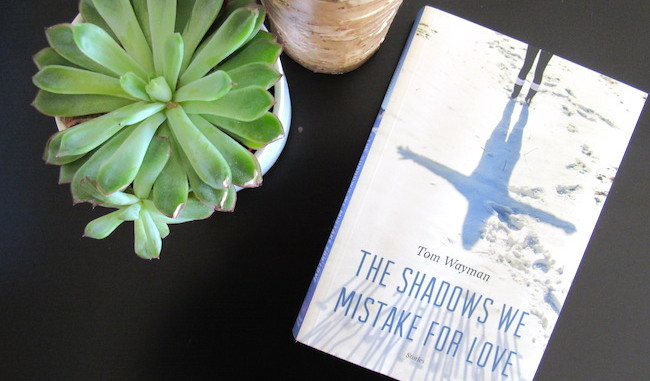
Award-winning author and poet Tom Wayman will be launching his new collection of short stories, The Shadows We Mistake for Love, on Tuesday, November 3 at Shelf Life Books. The stories, connected by geography, each detail the lives of individuals living in British Columbia’s interior. The cast of characters demonstrate the complexity of the region, and are inspired by individuals Wayman has either known or researched, along with various aspects of his own personality. We interviewed Wayman on his inspirations for The Shadows We Mistake for Lovein anticipation of the collection’s Calgary book launch.
Madison: What are your favourite and least favourite parts about the writing process?
Tom: Each part of the writing process—crafting a draft, revision, undergoing editing—have their pluses and minuses. The drafting of the original piece is exhilarating: I’m creating a world, including the individuals who inhabit it. But it’s definitely work to generate sentence after sentence, paragraph after paragraph, page after page: to sit at the keyboard hour after hour after hour. There are days or parts of a day when I’d prefer to be doing something, anything, else.
M: Are there any specific authors or works of literature that have inspired you as an author?
T: Of course! In Canada, Alistair MacLeod’s short stories and novel show how much can still be done with realist fiction, despite that approach being regarded by literary-flavor-of-the-month aficionados as passé. In the U.S., I still like Ernest Hemingway’s challenge to write so that not a single word in a story can be omitted. But my favourite U.S. fiction writer is the Arkansas author Donald Harington (1935-2009), who has been called “America’s greatest unknown writer.” His fiction draws from various contemporary stylistic modes without losing its tight connection to place: the people and landscapes of a particular Arkansas Ozarks locale. And internationally, B. Traven is my model (in translation, of course). He’s best known in North America for the novel from which the 1948 Humphrey Bogart film “The Treasure of the Sierra Madre” was made. But all Traven’s writing deals with the efforts of the underdog to fashion a life, and, in his series of novels about the 1911 Mexican Revolution, the efforts of the underdog to collectively create a better world. Traven’s politics are built from tortillas, beans, and coffee, like the lives of his characters and his wonderful stories.
M: I really liked the way each chapter almost had its own style of writing that reflected the featured character. How would you describe your writing style, and did you consciously work to make each chapter stylistically different?
T: The Shadows We Mistake for Love consists of 14 stories that were written over several years. I’m glad you liked the stories’ styles! Yet my intention wasn’t to have each story different stylistically. One of them, “Green Hell,” is essentially a dramatic monologue, but several others are each from the point of view of one character, written either in first person (“Along the Water Line,” for example) or third person (“Respect”). In the collection I did try out a couple of fictional approaches new to me: “The Three Jimmys” tells the story from three points of view of the founding of a motel in the 1950s. And I abandon chronological order in the title story, because its focus—contemporary single mothers—is such a familiar tale that I thought my recounting of this particular single mom’s story needed an infusion of energy to hold a reader’s interest.
M: The characters in the collection are connected through geography; however, they are all of different ages and personalities. Was there anything special you did to get inside each character’s head while writing?
T: My characters are amalgams of people I know or have researched in various ways (via observations, anecdotes told to me, etc.), plus aspects of myself. As you note, the challenge is to get inside these constructed personalities’ heads convincingly enough that the character appears to the reader to be a fully realized individual. When that work is successful, a character will often surprise me. In “Along the Water Line,” for example, I had no idea my much-put-upon narrator had a droll side to him if you push him too far. I was startled myself when, after the elderly landowner who has been barking at him declares she intends to go call the police, the narrator as she storms off calls after her: “Say hello to them for me.”
M: What inspired you to write about this region of Canada? Were the inhabitants of the area more of an influence, or was nature?
T: I think there’s a constant interaction between a place and its inhabitants. Most Canadians live where they do because they can find work there. Otherwise, they have to move where the work is—a long tradition in this country, and obviously very disruptive to family life, social cohesion, etc. Work in Canada is still based on the earth, despite all the nonsense that gets spewed about “the information economy” (information about what, and for what purpose?) or about how “investment creates wealth” (put a pile of money in a room by itself and see how much work it accomplishes). People need to be fed, clothed, housed, transported, educated, etc. But that all begins with primary resources: land and forests and animals and water. Cities are really parasitic on the rural (although of course nobody likes to think of themselves as a parasite, so the fragility of cities is ignored in the media and artistic creations and many destructive urban activities are praised as innovative, fashionable, “must-do”). At the very least, I wanted to show something about contemporary rural life, which is rather different now than how it’s been traditionally depicted in our literature. “The rural” is an abstraction, of course. Thus, I ended up looking specifically at where I live, with, as I say, its unique history as a destination for marginalized people, and its fascinating spectrum of current inhabitants.
The November 3rd book launch is free for all, and will be taking place from 7:00-9:00pm. For more information on The Shadows We Mistake for Love, visit the Douglas & McIntyre website.
Originally posted on calgaryisawesome.com



